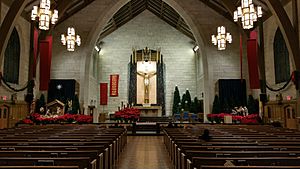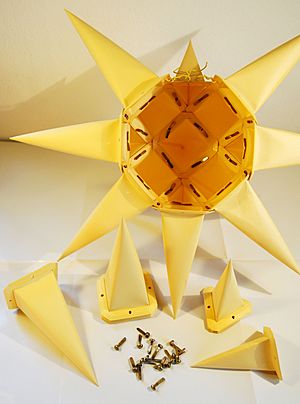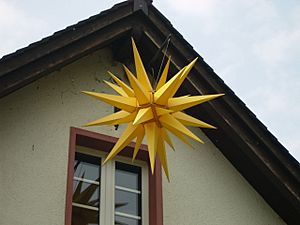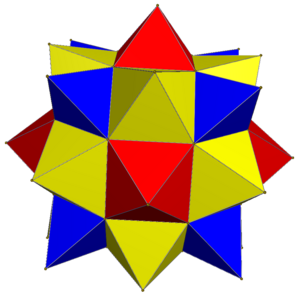Moravian star facts for kids
A Moravian star (called Herrnhuter Stern in German) is a special decoration often seen during the Advent, Christmas, and Epiphany holidays. It's popular in Germany and in places like the Lehigh Valley in Pennsylvania and Winston-Salem, North Carolina, where the Moravian Church has many followers. These stars get their name from the Moravian Church, which started in a region called Moravia. In Germany, they are known as Herrnhut stars because they were first made for sale in Herrnhut, a Moravian community in Saxony, Germany.
Contents
The Story of the Moravian Star
How the Star Began
The very first Moravian star was made in the 1830s. It started as a fun geometry project at a boys' school in Niesky, Germany. People first heard about a huge 110-point star made for the school's 50th birthday.
Around 1880, a former student named Peter Verbeek began selling these stars and instructions on how to make them. His son, Harry, later started the Herrnhut Star Factory. This factory was the main place where these stars were made until World War I.
The Star Factory Today
The factory was badly damaged at the end of World War II. However, it soon started making the stars again. For a short time in the 1950s, the government in East Germany took over the factory. But it was later given back to the Abraham Dürninger Company, which is owned by the Moravian Church. This company still makes the stars in Herrnhut today. Many other companies and groups now make these stars too. Some Moravian churches even have their members build and sell the stars to raise money.
Why Moravian Stars Are Special
A Symbol of Faith
The Moravian Church quickly adopted the star as an important symbol for Advent. In the past, Moravian communities were very focused on their Christian faith. Everything they did, even daily tasks, was seen as a way to worship. It didn't take long for making these stars to become a special activity for everyone in the community.
Stars Around the World
Moravian stars are still very popular decorations for Advent, Christmas, and Epiphany. You can see them all over the world, even in places where there aren't many Moravian churches. They are often placed in nativity displays and Christmas villages. They represent the Star of Bethlehem, which guided people to Jesus.
It's traditional to display these stars from the first Sunday in Advent (about four Sundays before Christmas) until Epiphany (January 6). You can spot large Advent stars in famous places like the Frauenkirche in Dresden and over the altar of the Thomaskirche in Leipzig.
Moravian Stars in America
The city of Winston-Salem, North Carolina, which has strong Moravian roots dating back to 1766, uses the Moravian star as its official Christmas street decoration. A huge 31-foot (9.4-meter) Moravian star, one of the biggest in the world, sits on top of the North Tower of Wake Forest Baptist Medical Center during the holiday season. Another star is displayed under Wake Forest University's Wait Chapel during Advent and Christmas.
The tradition of using these stars during the holidays is also found in the West Indies, Greenland, Suriname, Labrador, Central America, South and East Africa, and Ladakh in India. This shows how far the Moravian Church's missionaries traveled and shared their traditions.
Different Kinds of Moravian Stars
The Classic Herrnhut Star
The original Moravian star made in Herrnhut since 1897 has 26 points. It's made up of eighteen square-shaped points and eight triangular-shaped points. One point is usually missing where the star is mounted. This shape is known as an augmented rhombicuboctahedron. Each flat side of the main shape in the middle becomes the base for one of the star's points. This 26-point star is the most common type you'll see.
Other Star Shapes
There are other kinds of Christmas stars that look different from the original Herrnhut Moravian star. No matter how many points a star has, its shape is always symmetrical and based on polyhedra (3D geometric shapes). People often hand-make stars with 20, 32, 50, 62, or even 110 points. These different varieties come from changing the basic shape that the points are built upon. For example, if you use an octagonal (eight-sided) face instead of a square face, you get a different star.
The common 26-point Herrnhut Moravian star can become a 50-point star. This happens when the squares and triangles that make up the middle shape are changed into octagons and hexagons. This creates small, four-sided holes in the corners, which are then filled with irregular four-sided points. These extra points make a "starburst" pattern on the regular 26-point star.
Sometimes, Froebel stars, which are paper decorations made from folded strips, are mistakenly called Moravian stars.

See also
 In Spanish: Estrella de Moravia para niños
In Spanish: Estrella de Moravia para niños
- Barnstar





